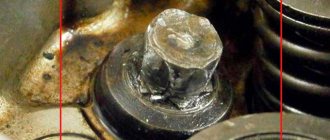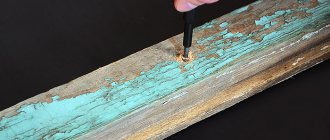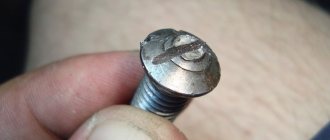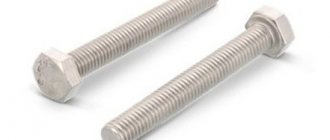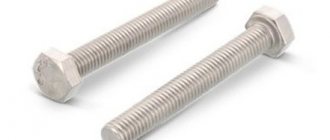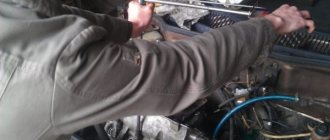Why do the edges of a screw, screw or bolt lick off?
Licking is the grinding down of the edges of a bolt or a screwdriver slot on the head of a screw, screw or self-tapping screw.
Both masters and beginners can encounter this problem. When the edges of the bolt are licked, the key begins to slip on it and it is not possible to unscrew such an element. The slots on the head of screws and screws can become damaged, which also leads to the screwdriver turning and making it impossible to unscrew the damaged fastener. Reasons why the splines of a screw, a screw or the edge of a bolt or nut can lick off:
- use of worn tools;
- incorrect use of a wrench or screwdriver;
- poor quality fastener.
If a key or screwdriver slips through while unscrewing the fastener, do not panic and need to figure out the reason. Sometimes it is enough to change the screwdriver or wrench to solve the problem immediately.
Licking is the erasing of edges or a slot for a screwdriver.
Screwdriver bit
A common problem with using power tools is the incorrect choice of operating speed. Use moderate force to drill out the fasteners. The operating time of the screwdriver should be short. If you drill a screw intensively, the slot will become deformed. As a result, you will have to additionally decide how to unscrew a screw with a damaged head, which will increase the time it takes to complete the work.
crosshead screwdriver
Possible causes of fastener damage:
- poor quality of the tool: the metal is too soft, which causes the screwdriver to constantly slip out, the sharp edges have become dull due to wear, this also does not allow the screw to be firmly fixed in the slot, in addition, the tool may be incorrectly selected for such work (does not match the head size);
- weak efforts in the process of unscrewing the fastener, while the screwdriver is not held in the slot, constantly slips, as a result the head is deformed, for this reason it is called “slipped”;
- At the installation stage, the fasteners were installed in a structure made of a material that does not match the screws, because of this it rotates; using a screwdriver it will not be possible to pull out such hardware.
Types of problematic screws
It is quite difficult to dismantle damaged fasteners, especially those made of dense material. But there are several effective ways to unscrew a screw with a broken thread or a deformed head. In this case, you need to choose the right tool, technology, take into account the type of fastener and thread direction.
With a broken head
Hardware with a damaged or broken head can be removed in the following ways:
- Dismantling with an extractor. This method works when others don't help. The tool is wedged in the hardware and turned out together with it. The adjacent material is not damaged. The method is suitable for fasteners made of any material except hardened steel.
- Welding. The severed head can be welded or a cold welding compound can be used. The restored hardware is removed using a screwdriver or electric drill.
- Drilling. It is used on a wooden surface in which the screw is recessed or has no top. The hardware is drilled out, and the same fastener of a larger diameter or a bolt is installed into the vacated cavity.
Torx and hex screws
Recently, fasteners with asterisk, hexagon and more exotic shapes have been increasingly used. If the edges on such a fastener are damaged and you need to unscrew it, then you can proceed by analogy with ordinary bolts with the only difference that to unscrew you need to use a tool with the appropriate shape of the edges.
Breaking edges under a screwdriver
Often, in the case of Phillips screwdrivers, the relief that allows the tool to be fixed in the head is simply destroyed. The reason for this is often poor quality materials from which such compounds are made.
In this scenario, we will need a chisel and a hammer. The task is to make a notch on the cap that can be caught with a screwdriver. After the latter has been created, we either use a regular screwdriver for its intended purpose, or, if the notch was created on only one side, a screwdriver is placed into it at an angle, which we will hit with a hammer as we unwind it.
With damaged thread
There are cases when the thread of the fastener is damaged. In this case, the hardware rotates freely, but it is not possible to remove it from the threaded connection. To solve this problem, you need to lift the bolt. This can be done using a screwdriver or other similar tool, which is inserted under the head and lifts it with force. When the bolt rests, it begins to rotate in the direction of unscrewing. This is done until the hardware is completely removed. If the hole in the threaded connection is through, then you can push from the reverse side using any suitable tool.
If you have a similar problem with the nut, then proceed in the same way. Hardware with damaged threads must be replaced, so if there is access, the nut can be cut off with a grinder or knocked down with a chisel.
Procedure for unscrewing a bolt with a broken head
Threaded connections become a real test when the head of the bolt breaks off as a result of applying force. If the parts can be separated, then dismantling the hardware will not be difficult. Much more time and effort will be required when the head breaks off and the fasteners still do not protrude from the base.
The procedure includes the following points:
- Use an appropriately sized extractor. These tools are made from a cylindrical rod. One side of the metal blank contains a tapered thread of the opposite type of cutting. The second side is equipped with a square shank. The use of the element is possible provided that the bolt is pre-drilled. In this case, the diameter should be 3 mm less than the thread. Then you need to select an extractor and hammer the device into the finished hole. Unscrewing a bolt with a torn head is done by carefully rotating the extractor shank.
- An excellent solution to the problem is to use a tap with a left-hand thread. The accuracy of the diameter must be observed, which must correspond to the thread value. The method involves pre-drilling a new hole and cutting a new thread. The approach will be difficult for those who do not know how to unscrew licked bolts. This will remove all parts of the broken bolt to the outside.
The easiest ways to unscrew a problem bolt
If you don’t have special tools at hand, there will probably be liquids that will help reduce friction in the connection and unscrew it. Such means are kerosene, diesel fuel or brake fluid. But the best option is WD-40, but not everyone has this aerosol product on hand. To apply the method, you just need to clean the joint with a wire brush, and then, if the location allows, drip one of the above products into the thread. In this case, you need to wait about a quarter of an hour and try to unscrew the connection.
As an alternative, you can try heating the soured bolt. As we all know very well from physics courses, metal expands when heated, and this will help break the bond in the thread.
Finally, you can use a gas key, which almost everyone also has at home. The features of this key are an extremely tight grip, as well as the ability to apply much greater force.
Sometimes you can unscrew a bolt simply by knocking. To do this, you need to tap the stuck hardware with the same hammer. But this must be done without overdoing it with force.
Preparatory activities
You should not start removing the damaged bolt immediately, but after first completing a series of so-called preparatory procedures. The order of these works is as follows:
We all know that in the modern market the quality of products is falling and falling. Some associate it with the desire to cut costs, others with a shorter service life and therefore replacement with the same product or a more “modern” one. I can’t say anything, but lately I’ve often wondered how to unscrew a broken screw on a laptop.
or other household appliances, because if you screw it in and out several times, in a modern laptop you will most likely tear off the slots, and this is very unpleasant. In fact, this problem occurs not only in household appliances and electronics, but also in many areas where fasteners are used, and now we will explain how to unscrew a screw with a broken slot.
How to act at the first sign of torn edges
If, while unscrewing a screw or self-tapping screw, you see that the screwdriver or bit begins to turn at the edges of the head, do not panic. Sometimes it is enough to take a new screwdriver and the problem is solved. When tightening such fasteners, you should not hammer it or try to tighten it to the end. In the case where the problem arose while tightening the screw, you should try to unscrew the fastener and replace it with a new one.
Tool change
If the screwdriver constantly jumps off the slot, the reason may be that the tip is worn out. In this case, the tool is replaced. A new screwdriver is inserted into the screw head, making sure that the tip is pressed tightly against the slot, firmly inserted into the grooves, and try to unscrew the fastener.
Useful advice from Novate.ru: If the fastener cannot be unscrewed, the first thing to do is stop. Attempts to continue unscrewing can aggravate the situation, and a screwdriver that constantly jumps off can damage the material. Assess the condition of the screw and try other removal methods.
Gas key
This method is used when unscrewing bolts, since they have a protruding head that you can grab onto. For this:
- Clean the bolt head.
- Lubricate the joint with kerosene or diesel fuel, a liquid like WD-40 works well, and leave for 15–20 minutes.
- Unscrew the bolt. They do this with a gas wrench. With its help, a lot of force is created and it is possible to grip even a round head well.
The disadvantage of this method is that it is not always possible to get a gas wrench to the desired bolt.
Cutting new edges
If the bolt is large, then using a grinder you can cut new edges on it. It is enough to make only 4 of them and use a smaller key to unscrew the bolt. You can cut new edges on a bolt with a file, but this is more difficult and takes longer. You can make a cut on the head of a screw or screw using a hacksaw or grinder.
Hammer and chisel or impact screwdriver
This option is more suitable for licked nuts or fairly large screws. The chisel is pressed against the head of the fastening element and, hitting it with a hammer, the screw or nut is gradually turned. Small screws or screws can be removed using an impact driver and a hammer. After loosening the fastening, the work is done with a regular screwdriver.
Epoxy resin
It is not always possible to use a soldering iron; for example, the plastic case of a laptop can be melted. In this case, you can use super glue or epoxy resin.
- Pour glue into the licked slot and insert a screwdriver.
- Let the glue harden.
- A new pattern is formed in place of the screwdriver.
This method is suitable for screws with a small diameter, since the glue crumbles with great force.
Quite often it happens that the edges of fasteners are torn off during construction work. Usually this happens at the most inopportune moment, when you need to complete the task on time. How to unscrew a screw with stripped edges? Why do such troubles arise? What solutions solve the problem? We will talk about all this later in the article.
Band or piece of rubber
In this case, use a small part of a medical tourniquet or a piece of thick rubber. The selected material is placed on top of the head of the screw or screw, after which it is pressed with a screwdriver and gradually turned. The presence of rubber will help increase friction and solve the problem.
The harness is placed between the screwdriver and the head of the screw or screw.
Using a hammer
The hammer has a sharp end, so it provides reliable engagement with the head of the screw or screw. In order to unscrew the problematic fastener, the core is pressed against the head at an angle of 45°, after which it is carefully struck with a hammer in the direction opposite to the screwing. As soon as the fastening is loosened, the screw is unscrewed with a screwdriver.
Using pliers
The method is relevant only if the screw head is located on the surface of the material and is not recessed into it. The side parts of the cap are grabbed with pliers and rotated to the side counterclockwise. If the screw gives in, there is no need to rush - it is better to act slowly and carefully.
Regular or left hand drill
Left-handed drills with counterclockwise rotation are available for sale. They improve tool centering and reduce the load on the drill, which gives higher productivity and drilling accuracy. By inserting such a tool into a drill, you can unscrew a screw or screw with a licked head.
If you don’t have a left-handed drill, you can try to drill out the stuck fasteners using a regular one. In this case, you need to take a drill whose diameter is smaller than the diameter of the bolt or screw. You must act carefully so that you do not have to cut threads for new fasteners later.
The drill bit should have a diameter smaller than that of the problem bolt
Drill and bit
In order to unscrew a screw with broken splines, you can use a drill or a screwdriver and a drill bit. This method is often used in service centers; it causes minimal damage to the device body.
- It is enough to choose a metal drill a little thinner than the screw head and drill it out, leaving only the leg.
- After this, the leg can be removed using long-nose pliers.
This method is well suited for removing screws in laptops and phones. These devices are disassembled for repairs, replacement of components or for maintenance and disassembly - this is the main problem that every repairman faces.
Using welding or strong glue
If you have a welding machine, you can weld a nut or rod to the damaged head, and then simply unscrew the connection in the usual way. The method works ideally with small bolts on our equipment, where low-quality metal products are often used. Of course, such delicate work cannot be done by welding, but nothing prevents you from using superglue. You just need to take really strong and high-quality products, and at the same time be extremely careful so as not to glue the bolt or nut itself, only complicating the situation.
Plug drill
If the screw is so deep in the wood that there is no way to get to it, but you need to remove it, you can use a plug drill. It makes neat holes and is used to remove material around the stuck fastener.
Tightening until it stops
An important method is the so-called “method by contradiction”: in order to loosen the fastening of a stuck part, you should not unscrew it, but, on the contrary, try to screw it tighter, until the end. This will make the bolt or nut move more freely, which will ultimately help in removing the rusty fastener.
Solder and soldering iron
If you need to unscrew a small screw or cog, use a soldering iron and solder:
- Heated solder is dripped onto the head of the fastener with licked edges.
- While the tin has not hardened, insert a screwdriver into it and wait a few minutes.
- Heated solder is dripped into the screw slots and a screwdriver is inserted.
- Unscrew the problematic screw and clean the solder tip of the screwdriver.
Tapping
Tapping promotes the gradual destruction of scale and rust. To properly dismantle the fastening materials, you need to take a small hammer and strike, trying to turn the hardware. This method helps to quickly unscrew the connection.
The unscrewing force should be moderate so that you do not have to drill additional holes. If the process is performed correctly, it is necessary to thoroughly clean the bolts from rust and treat them with graphite lubricant.
Thermal method
If the above methods do not give the desired result, there is only one way out - fire. Heating of the elements and instant cooling allows you to quickly free the threaded connection from scale. After heating with a gas burner or other device, the hardware must be cooled with machine oil.
In almost any situation, the bolts can be unscrewed using improvised means. All you need is a flathead or Phillips screwdriver, open-end wrenches, sockets, lubricant and a little effort.
Using solvents
High-quality anti-rust and anti-scale compounds are expensive and are the most effective means. However, you can find many budget options of domestic production on the market.
The most popular is the aerosol composition WD 40. The substance quickly penetrates into micro-gaps and gradually dissolves corrosion. In addition, hardened bolts are unscrewed using brake fluid, kerosene and white spirit. To achieve maximum effect, you should wet any fabric with the substance and wrap it around the hardware for a while.
Increased friction force
To increase the adhesion between the screwdriver tip and the fastener cap, it is enough to place auxiliary material between them. Here you can use a piece of an abrasive sponge, a piece of steel wool, rolled up tape, or a thin strip of rubber. One of these materials should be applied to the damaged screw head and try to remove it again using a regular screwdriver.
Unscrewing with an extractor
If possible, we use method No. 4, it is very convenient. An extractor is a tool specially designed for unscrewing licked or broken bolt heads, screws and other parts. The principle of use is almost the same as with a bat. First you need to select an extractor suitable for the recess. It is attached to a screwdriver and the stuck screw is removed with pressure.
Crimping a protruding thread head
In the case where part of the screw protrudes above the surface, you can unscrew it by crimping the head with pliers. To do this, it is best to use thin pliers (duckbills). With their help, they clamp the tip of the screw and begin to rotate counterclockwise. Instead of pliers, you can use a drill chuck. They crimp the head and unscrew the screw.
Use a drill chuck to compress the head of the self-tapping screw and unscrew it
Using a left-handed drill
It is possible to unscrew the bolt with a drill. It is necessary to purchase a tool in the store with a left-hand spiral. The process is the same as with conventional drilling, but using reverse rotation.
Using core
This option is good for loosening small bolts. The core is pressed to the edge of the head at an angle of approximately 45 degrees and lightly tapped with a hammer in the direction in which the bolt should be unscrewed. The core, due to its sharpness, adheres well to the part, so the chances of its removal are high.
Cutting a new slot
Another way to unscrew stubborn fasteners is to apply a new notch to the head of the stripped screw. Using an engraver with a cutting disc, we will cut a groove in the subject’s hat. Then use a flat-head screwdriver to unscrew the fasteners.
Precautionary measures
When choosing a way to unscrew a screw with torn edges, you must follow the recommendations:
- when using an auxiliary tool, you should control the intensity of the applied forces: sometimes, in order to remove the fastener faster, you have to press harder on it, but the situation will worsen in this case and, conversely, too careful actions with weak pressure will lead to even faster erasure of the edges of the slot;
- when the fastener is unscrewed too intensively or an auxiliary tool is used, during work with which metal shavings are formed (a hacksaw, etc.), it is necessary to periodically remove them, since the presence of foreign particles causes the tool to not fit tightly enough to the edges of the slot, what will slow down the work;
- It is recommended to wear safety glasses when removing a screw without a head, since during the procedure, metal shavings may form when using a power tool;
- you need to know which way to unscrew the screw, so, in most cases, hardware is made with a right-hand thread, which makes it possible to install the fastener by screwing it clockwise, and it is removed, on the contrary, when the screwdriver moves in the opposite direction.
When using an auxiliary tool, the intensity of the applied effort should be controlled
Using welding or strong glue
If you have a welding machine, you can weld a nut or rod to the damaged head, and then simply unscrew the connection in the usual way. The method works ideally with small bolts on our equipment, where low-quality metal products are often used. Of course, such delicate work cannot be done by welding, but nothing prevents you from using superglue. You just need to take really strong and high-quality products, and at the same time be extremely careful so as not to glue the bolt or nut itself, only complicating the situation.
Why is a rusty bolt or nut difficult to unscrew?
Any metal fastener inevitably undergoes corrosion and rust over time. The process is accelerated if the bolts and nuts are often exposed to aggressive environments:
- contact with water;
- interaction with chemicals, including detergents;
- street dirt, dust, caustic salts - they accelerate the corrosion process.
Despite special protective coatings against rust, if the surface of the fastener has been even slightly damaged, then over time the process of destruction is inevitable.
After some time, the rusted bolt must be removed and replaced, but a problem often arises - it will not unscrew. Due to the oxidative processes of the metal, rust grows on fasteners and parts and the surfaces “grab” together. If this process develops at the location of the bolt thread, then the situation becomes even more difficult.
Shape of the secret
First you need to figure out what type of modules are on the wheels in order to understand how to remove the secret from the wheel without a key effectively and quickly with your own hands.
There are only four types of bolt head shapes. Among them:
Simplified rectangular models with a number of faces from 4 to 40.
Curly profiles with printed lines of different configurations and shapes.
Hole profiles are profiles with a number of holes of various diameters and depths. They are the most reliable due to the 100% uniqueness of the key.
Combined - specimens that combine figured and perforated profiles.
Recommendations for working with screw heads and self-tapping screws
While performing the above work, in order to get the expected result and avoid injury, you must adhere to the following rules:
- Before attempting to unscrew the screw, you need to inspect the back side of the workpiece. If its end peeks out of it, then you can try to unscrew it from this side, and when the head is free, grab it with pliers;
- you need to decide whether the thread on the fastener is right-handed or left-handed in order to unscrew the screw or self-tapping screw in the correct direction;
- after the screw has been unscrewed, you can ensure reliable fastening in this place using a larger self-tapping screw or you can use a bolt with a nut;
- When using the described methods, nicks and chips are formed, so in order to avoid injury, you must work with protective glasses and gloves.
There are no lose-lose situations. If there is a problem with unscrewing a screw, screw or self-tapping screw, you need to assess the situation, choose one of the described methods, and then use it to remove the fastener.
How to prevent edges from being torn off
To prevent such a problem as torn edges of a bolt or splines of a screw or screw from taking you by surprise, you must adhere to simple rules:
- You need to buy only high-quality fasteners that have high strength and reliability;
- When tightening and unscrewing screws or screws, do not allow the screwdriver to slip through the slots. This leads to their abrasion and it will be difficult to unscrew such fasteners;
- You should always monitor the condition of the instrument. If a screwdriver or key has licked edges, then it will be difficult to unscrew a screw, bolt or screw with their help.
It is much easier to prevent the edges of bolts, screws and screws from licking off than to then unscrew damaged fasteners.
Do not panic if a problem appears such as a licked bolt head or slots on the head of a screw or screw. There are many ways to solve it. It is necessary to adequately assess the situation and choose one of the available options.
Self-tapping screws with stripped splines (asterisk)
If overheated screws are unscrewed/twisted a couple of times, their edges lose their sharpness, the screwdriver turns, but the screw itself remains in place. If it “sits” in wood, plaster, chipboard or other similar, not too hard materials, you can put a thin elastic band (for example, for hair) under the screwdriver. Due to the elastic force, a tighter fit is achieved to the remaining edges, which helps to move the self-tapping screw from its place. Other methods are more “traumatic”:
- Cut grooves inside the “licked” funnel using a flat-head screwdriver and unscrew. This method is quite dangerous: if the walls of the “funnel” are too thin, there is a chance that the screw head will simply crumble from the effort. All that remains is a screw that cannot be unscrewed.
It’s already difficult to unscrew such a self-tapping screw
Unscrew the self-tapping screw with torn edges (cross)
The remains of a bolt or stud without a head can be unscrewed as follows: cut a left-hand thread in the remaining body, drip “moment” glue, screw in the left-hand tap, and leave for an hour. Apply some oil to the main thread and leave for an hour. When the glue sets, unscrew it. If the remains of a self-tapping screw are stuck in the wood, it is easier to seal this hole and install another fastener nearby.
Source: stroychik.ru
Useful tips
Before deciding to use drastic measures to unscrew a stripped screw, inspect the back surface of the structure. Of course, if you have access to it. It is likely that the fastener has gone through and can be grabbed with pliers and forcibly unscrewed. Be sure to ensure that the threads are threaded in the correct direction, as the screw can have either left-handed or right-handed threads.
In the case when, after removing a broken screw, a larger hole remains in the body of the base, the assembly can be strengthened with larger hardware and sealant. An alternative solution is a fastener consisting of a bolt, washer and nut.
To facilitate the process of unscrewing a broken screw, it is necessary to reduce the friction force. You can use various lubricants, for example, WD-40. After removing the deformed hardware, the grease must be removed and the hole used to install a new screw.
And finally - remember about safety precautions! Deformed screws develop burrs and other damage that can lead to injury. You should work carefully, carefully, using personal protective equipment such as gloves and goggles.
Need some advice? Request a call! Send a request for fasteners
01.04.2020
Video - The best ways to remove a broken screw
Sources
- https://bumper.guru/klassicheskie-modeli-vaz/poleznoe/kak-otkrutit-bolt-s-sorvannymi-granyami.html
- https://vseprokrepeg.ru/stroitelstvo/otkrutit-shurup
- https://krepmetiz.ru/stati-po-krepeju/kak-vykrutit-sorvannyj-vint
- https://ingener-pto.ru/2019/12/12/kak-vyvernut-vint-s-sorvannoj-golovkoj/
- https://mehmanxona.ru/tehnologii/kak-otkrutit-slizannyj-vint.html
- https://tehznatok.com/kak-polzovatsya/kak-otkrutit-shurup-s-sorvannoy-krestovinoy.html
- https://banya18.ru/banshhikam/kak-otkrutit-shurup-s-sorvannoj-krestovinoj-prostye-sposoby
- https://mo-dmitr.ru/pro-tehnologii/kak-otkrutit-slizannyj-vint.html
- https://sdelai-lestnicu.ru/strojmaterialy/kak-vykrutit-vint-s-sorvannoj-krestovinoj-i-so-slizannymi-granami-pod-krestovuu-otvertku-kak-otvernut-treugolnyj-vint-i-prikipevsij
- https://KrepezhInfo.ru/7-effektivnyh-metodov-vykruchivaniya-slizannogo-bolta/
- https://SumkiVTrende.ru/tehnologii/kak-otkrutit-shurup-s-sorvannoj-krestovinoj.html
- https://traiv-komplekt.ru/articles/kak-otkrutit-sorvannyy-shurup/
- https://mebel-exp.info/kak-otkrutit-shurup-bez-otvertki/
